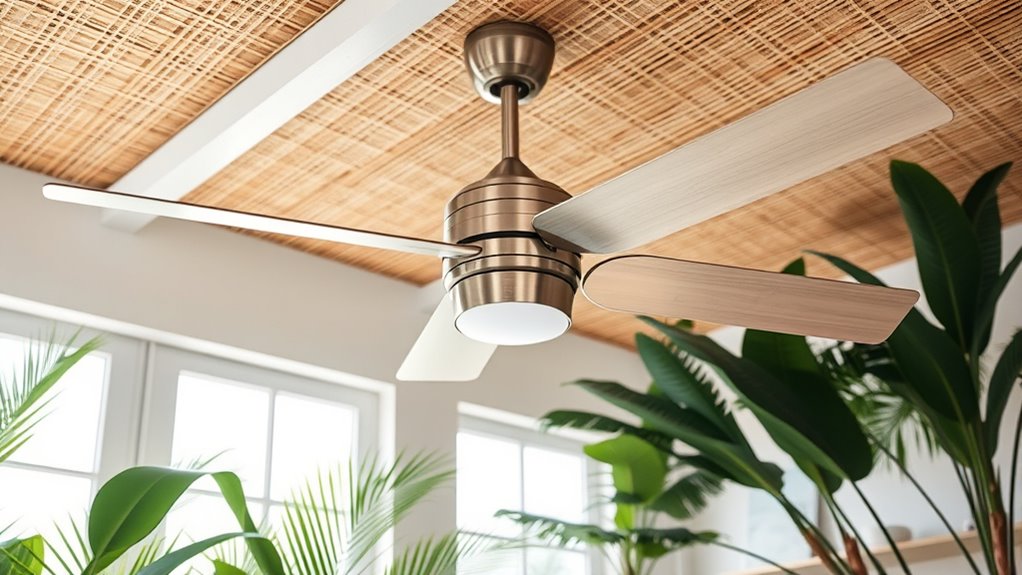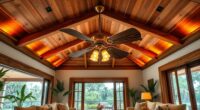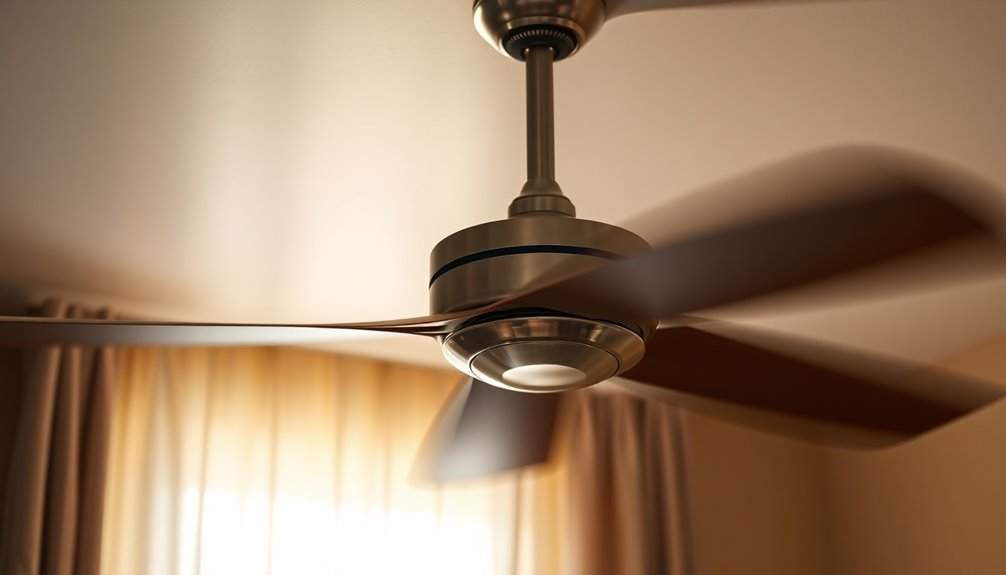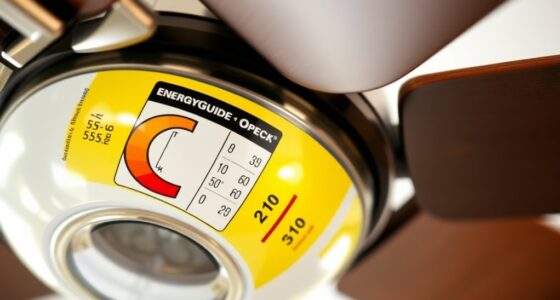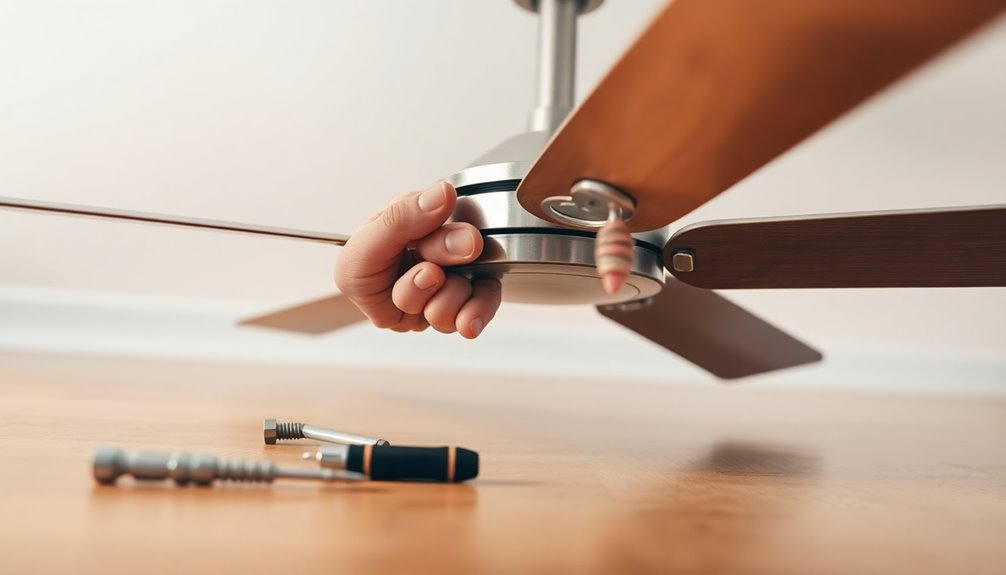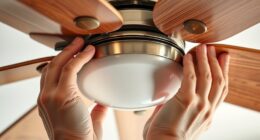When choosing ceiling fans for humid climates, opt for models made from corrosion-resistant materials like marine-grade aluminum or stainless steel. Make sure they have proper weatherproof ratings—damp-rated for covered areas or wet-rated for exposed outdoor spaces. Look for blades with protective finishes that resist warping and rust. Proper installation and regular maintenance are key to long-lasting performance. To find out more about selecting the best fans for your environment, keep exploring further.
Key Takeaways
- Select fans made from corrosion-resistant materials like stainless steel, aluminum, or marine-grade components.
- Ensure fans have appropriate ratings—damp-rated for covered areas, wet-rated for outdoor exposure, or coastal-rated with WeatherMax® technology.
- Opt for blades constructed from waterproof or treated materials such as PVC, composite, or weather-resistant wood.
- Use sealed motors with weatherproof seals and corrosion-resistant hardware for durability in humid environments.
- Regularly clean and inspect fans to prevent salt buildup, rust, and deterioration, extending their lifespan.
Understanding the Impact of Humidity on Ceiling Fan Performance
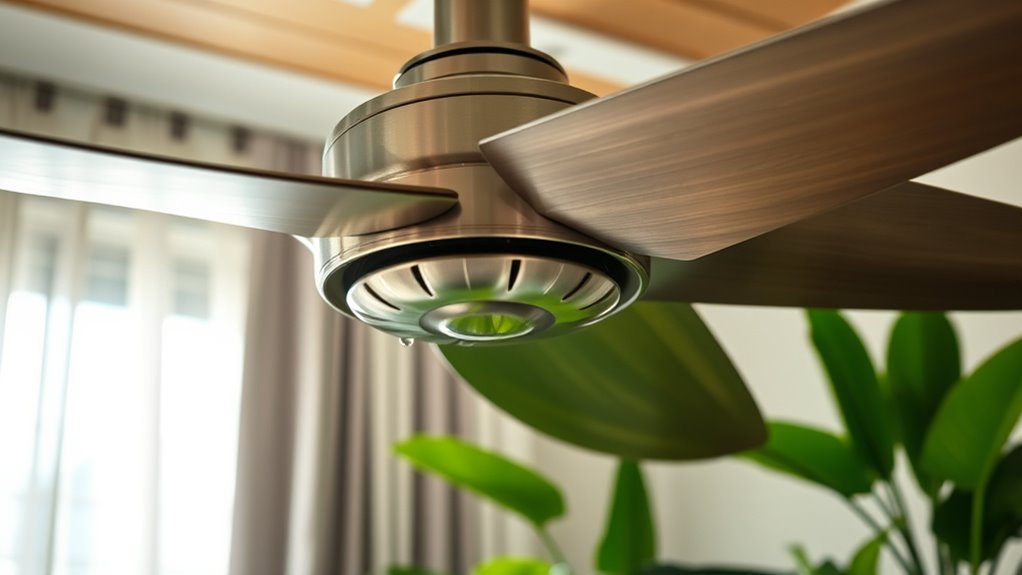
Humid conditions can considerably affect how well your ceiling fan performs. High humidity levels can make fans seem less effective because moisture in the air slows evaporation from your skin, reducing the cooling sensation. To combat this, choose fans made with corrosion-resistant materials like stainless steel or aluminum, which withstand moisture better. If you’re installing a fan outdoors or in damp areas, opt for wet-rated or damp-rated models designed to handle humidity without rusting or warping. Proper airflow depends on these qualities, ensuring your fan runs efficiently over time. Regular maintenance, such as cleaning blades and checking for moisture buildup, is essential to maintain ideal airflow and prolong your fan’s lifespan. Additionally, selecting best modern toilet models can improve overall bathroom comfort and hygiene, complementing your fan’s functionality. Being aware of humidity’s impact on appliances can help you make more informed choices for a comfortable and durable setup. Incorporating ventilation strategies can further enhance airflow and reduce moisture accumulation indoors, especially in humid climates.
Selecting Materials Resistant to Corrosion and Rust

Choosing the right materials for your ceiling fan is essential to guarantee durability and performance in humid or coastal environments. To prevent rust and corrosion, opt for fans made from stainless steel or marine-grade materials, which are designed for harsh conditions. These materials undergo rigorous testing to ensure they resist salt spray, moisture, and temperature changes, maintaining their integrity over time. Moreover, selecting fans with corrosion-resistant finishes can further extend their lifespan in challenging environments.
Choose stainless steel or marine-grade materials for durability in humid or coastal environments.
Additionally, look for fans with powder-coated or weatherproofed finishes that add an extra layer of protection against moisture. Sealed motor housings also help prevent moisture infiltration, reducing electrical issues.
- Use fans with blades made from composite, plastic, or treated wood for added resilience.
- Choose rust-proof components to extend your fan’s lifespan.
- Prioritize corrosion-resistant finishes for maximum durability.
Choosing the Right Rating: Damp, Wet, or Coastal

Selecting the appropriate ceiling fan rating guarantees it can withstand the specific environmental conditions of your outdoor space.
If your area experiences high humidity but is covered, a damp-rated fan is suitable, as it handles moisture exposure without being waterproof.
For spaces exposed to direct rain or snow, a wet-rated fan is necessary, tested against heavy water contact and harsh weather.
If you live near the coast with salt air, UV, and corrosive conditions, a coastal-rated fan with WeatherMax® technology offers superior resistance.
Choosing the correct rating ensures your fan performs reliably, lasts longer, and remains safe.
Understand your environment’s moisture exposure level to select the right rating—damp, wet, or coastal—and provide your outdoor space with superior comfort and durability.
Evaluating Blade Design and Durability for Moist Conditions

When evaluating ceiling fan blades for moist conditions, focusing on durable materials and protective finishes is essential. Choose blade materials like PVC, composite, or treated wood, which resist warping and moisture damage.
Aerodynamic blades with curved or beveled edges improve airflow efficiency and reduce resistance caused by moisture. Ensure blades are coated with protective finishes such as epoxy or corrosion-resistant paint to prevent rust and deterioration over time.
These features help blades withstand moisture-induced wear and maintain performance.
- Opt for blades with moisture-resistant coatings or finishes
- Prioritize aerodynamically designed blades for better airflow
- Regularly inspect blades for signs of warping or corrosion
Selecting the right materials and design guarantees your ceiling fan remains durable and effective in humid environments.
Considering Motor Quality and Weatherproof Seals

When choosing a ceiling fan, you need to prioritize motor durability and weatherproof seals to guarantee long-lasting performance. Look for motors that meet high durability standards and have effective seals to keep moisture out. These features are essential for preventing rust, electrical failures, and mechanical wear in humid or coastal environments. Additionally, selecting fans with protective styling benefits can help extend the lifespan of your fixture by reducing exposure to damaging elements. Incorporating fans with specialized coatings can further enhance resistance to corrosion caused by humidity, aligning with ongoing advancements in automation in business that emphasize durable and efficient systems. Moreover, choosing fans with high-quality components ensures optimal operation and longevity in challenging climates. Properly designed ventilation systems can also improve airflow and reduce the accumulation of moisture around the fan, further protecting its components.
Motor Durability Standards
Ever wonder what makes outdoor ceiling fans last in harsh conditions? It all comes down to motor durability standards. High-quality fans feature corrosion-resistant motors with sealed bearings, preventing damage from salty air and humidity.
Thermally protected motors ensure the fan can operate continuously without overheating, even in humid environments. Additionally, using moisture-resistant materials for motor windings helps reduce electrical failures caused by humidity. Vetted – 1st Home Theatre Projector
Manufacturers often test these features through salt spray tests and humidity simulations to guarantee long-term performance. Choosing a fan with these elements means your motor can withstand the challenges of outdoor humid climates.
Look for:
- Corrosion-resistant motors with sealed bearings
- Thermally protected motors rated for continuous operation
- Motor windings made from moisture-resistant materials
Seal Effectiveness in Moisture
The effectiveness of weatherproof seals plays a vital role in maintaining motor integrity in outdoor ceiling fans. Well-designed weatherproof seals prevent moisture ingress, which can cause corrosion and damage over time. Proper installation according to local fire safety regulations and regular inspections help ensure these seals remain effective and the fan operates safely and efficiently. Look for fans with sealed motors featuring high-quality gaskets that create a tight barrier against humidity and rain. Marine-grade fans often use corrosion-resistant materials like stainless steel and sealed electrical components to enhance seal effectiveness. Properly rated damp or wet outdoor fans undergo rigorous moisture simulations, including rain and humidity tests, to ensure their seals hold up in humid environments. Additionally, artificial aging tests simulate long-term exposure to moisture, helping manufacturers verify seal durability. Implementing moisture-resistant materials during manufacturing can significantly improve the longevity of seals in harsh conditions. Regular maintenance, such as cleaning and inspecting gaskets, helps sustain their moisture resistance. Selecting fans with proven seal effectiveness ensures durability, reduces repair costs, and keeps your fan functioning smoothly despite the humid climate. Incorporating advanced sealing technologies can further enhance moisture protection and extend the lifespan of outdoor ceiling fans.
Opting for Energy-Efficient and High-CFM Models
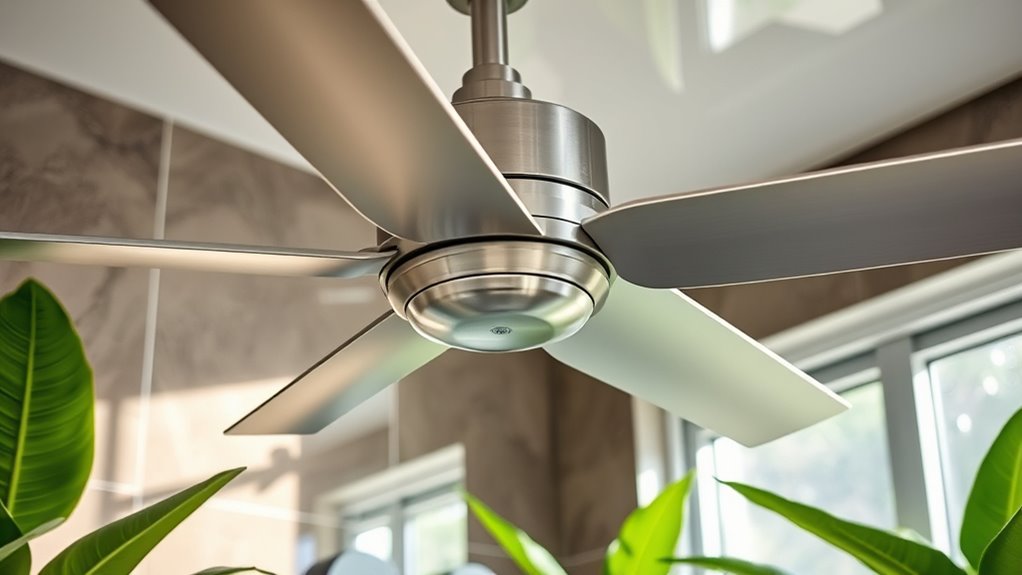
Choosing energy-efficient and high-CFM ceiling fans guarantees you get ideal airflow while minimizing power consumption. Look for fans with high airflow ratings (CFM) to ensure maximum circulation in humid environments. An ENERGY STAR® rated fan uses advanced motor technology and LED lighting, reducing energy use by up to 60%. Additionally, fans designed specifically for humid climates often incorporate features like moisture-resistant blades and sealed motor housings to enhance durability and performance. Selecting fans with moisture-resistant materials such as aluminum or stainless steel can significantly extend their lifespan in high-humidity settings. Fans equipped with DC motors provide higher CFM output while consuming less electricity compared to traditional motors. Incorporating Proper ventilation techniques can further improve airflow and help maintain comfort in humid conditions.
Ensuring Proper Installation and Mounting for Outdoor Use

Proper outdoor ceiling fan installation is key to safety and performance. You need to secure the fan with sturdy, corrosion-resistant hardware and mount it at the right height for ideal airflow. Ensuring all electrical connections are weatherproof and using compatible fixtures will protect your fan from the elements. Incorporating proper ventilation techniques can further improve airflow efficiency and prolong the lifespan of your outdoor fan.
Secure Mounting Techniques
To guarantee your outdoor ceiling fan remains secure and functions safely, start by selecting a sturdy ceiling mount bracket rated specifically for outdoor use. This ensures a secure mounting that can support the fan’s weight and resist corrosion. Make sure the hardware is made from corrosion-resistant materials like stainless steel or coated metal suited for humid environments.
Use a weatherproof conduit to protect electrical wiring from moisture, and install the fan with the appropriate downrod or flush mount based on your ceiling height. Proper installation includes securing all fasteners tightly and verifying the fan’s level alignment. Additionally, selecting an appropriate mounting height is crucial for optimal airflow and safety in humid climates.
- Choose a corrosion-resistant, weatherproof conduit for electrical safety
- Use a durable, outdoor-rated downrod for stability
- Follow manufacturer instructions carefully for secure mounting
Suitable Mounting Heights
Ensuring your outdoor ceiling fan is mounted at the correct height is essential for safety and performance. The ideal mounting height is at least 7 feet above the floor, especially in humid climates, to prevent accidents and optimize airflow. For sloped ceilings, use appropriate brackets or adapters to maintain proper orientation and function. Many outdoor fans feature longer downrods to accommodate higher mounting points, such as on patios or decks, avoiding headroom issues. Proper installation also involves securely anchoring into ceiling joists or beams to withstand outdoor conditions. Here’s a quick overview:
| Ceiling Type | Recommended Mounting Height | Special Consideration |
|---|---|---|
| Flat Ceiling | 7 feet minimum | Ensure secure attachment |
| Sloped or Angled Ceiling | Use brackets or adapters | Maintain proper fan orientation |
| High Patios or Decks | Longer downrods | Maximize airflow, prevent wobble |
| Outdoor Environments | Follow manufacturer specs | Ensure corrosion resistance |
Adhering to these guidelines guarantees proper installation for outdoor ceiling fans in humid climates.
Weatherproof Fixture Compatibility
When installing an outdoor ceiling fan, verifying that it’s rated for the specific environmental conditions is essential for durability and safety. Look for damp-rated, outdoor fans designed to withstand humidity and moisture.
Guarantee the weatherproof fixture you choose is properly sealed to prevent water intrusion, especially in humid climates. The mounting bracket and canopy should be made from corrosion-resistant materials like stainless steel or coated aluminum to resist rust.
Proper installation includes sealing electrical connections and choosing a secure mounting surface. This ensures your fan remains functional and safe over time.
- Confirm the fan’s weatherproof fixture is suitable for your environment
- Use corrosion-resistant mounting hardware for durability
- Follow manufacturer guidelines for sealing electrical connections
Matching Fan Style and Finish to Your Outdoor Space

Choosing the right ceiling fan style and finish enhances your outdoor space by creating a cohesive look that complements your decor. For a natural or coastal vibe, select finishes like oil-rubbed bronze, matte black, or brushed nickel, which blend seamlessly with outdoor textures.
Match blade styles, such as weather-resistant wood or matte-finished plastic, to your outdoor style—whether modern, rustic, or coastal. Coastal environments benefit from corrosion-resistant finishes like Coastal Max® technology in white or bronze, ensuring durability and nautical appeal.
Consider the overall style—sleek and minimalist for contemporary patios or ornate for traditional porches—and coordinate the fan’s finish with outdoor fixtures and furniture. This harmony elevates your outdoor space’s aesthetic and ensures a polished, inviting look.
Maintenance Tips to Extend Your Fan’s Lifespan in Humid Environments
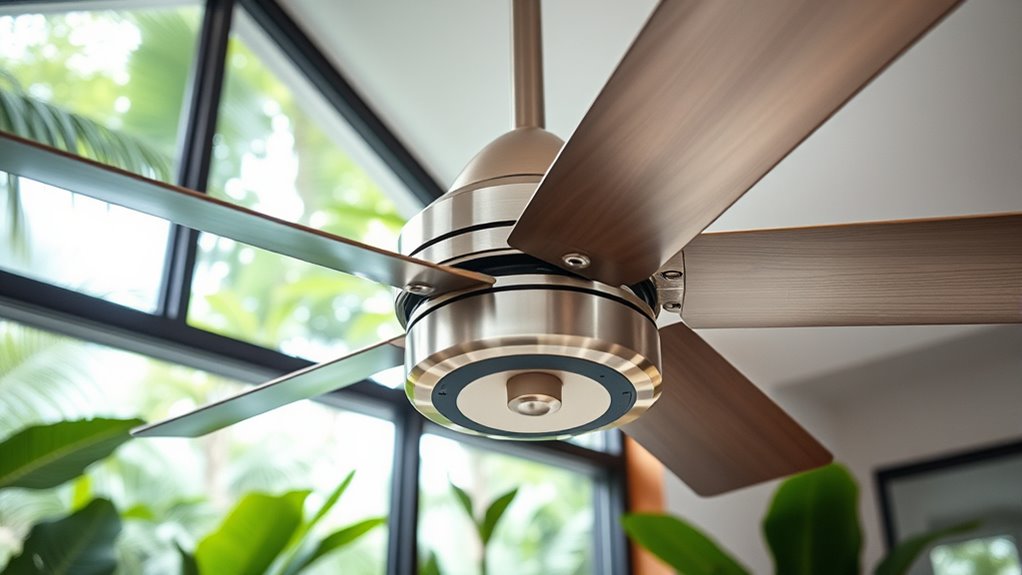
Maintaining your ceiling fan properly can considerably extend its lifespan, especially in humid environments where moisture can accelerate wear. To protect your fan, regularly clean the blades and motor housings with a damp cloth to prevent salt and moisture buildup, which can cause corrosion.
Proper maintenance extends ceiling fan life, especially in humid environments, by preventing corrosion and wear.
Inspect and tighten all mounting hardware periodically to avoid wobbling and unnecessary stress on components. Applying a corrosion-resistant coating or lubricant to moving parts annually helps improve durability in high-moisture settings.
To further reduce humidity-related damage, consider using a dehumidifier or improving ventilation indoors. For outdoor fans, choose models with corrosion-resistant materials like stainless steel or aluminum, and ensure they’re rated for outdoor wet or marine environments.
Proper maintenance is key to maximizing your fan’s lifespan in humid conditions.
Recognizing When to Invest in Marine-Grade Ceiling Fans

If you notice salt buildup, rust, or blade warping on your outdoor fans, it’s a clear sign you need marine-grade models.
These fans are built with corrosion-resistant materials and tested for harsh coastal conditions, ensuring they last longer.
Upgrading to marine-grade ceiling fans protects your investment and keeps your outdoor space comfortable.
Durability in Salt Air
When your outdoor spaces are exposed to salty, humid air, investing in marine-grade ceiling fans becomes essential. These fans are built with corrosion-resistant materials like stainless steel and aluminum, designed to withstand harsh salt air. They undergo rigorous testing, including salt spray and high humidity exposure, ensuring long-term durability in coastal environments.
Marine-grade fans feature sealed motors and weatherproof components that prevent rust, oxidation, and electrical failures caused by salt-laden air. They also use specialized finishes like powder coating and marine-grade paint to maintain their appearance and prevent deterioration over time.
- Choose marine-grade fans for peace of mind in salty environments
- Look for corrosion-resistant, weatherproof construction
- Invest in durable fans that resist oxidation and reduce maintenance
Weather Resistance Levels
Understanding the weather resistance level your ceiling fan needs is key to choosing the right model for outdoor spaces. If your area experiences salt air, high humidity, or rain, look for fans with a wet rating or damp-rated design.
Marine-grade ceiling fans are specifically engineered with corrosion-resistant materials like stainless steel and aluminum, making them ideal for salty, humid environments. These fans feature sealed motors and weatherproof blades that resist warping, fading, and rust caused by moisture and salt air exposure.
Investing in marine-grade fans guarantees durability and performance in outdoor settings directly exposed to harsh weather. Recognizing when to choose these specialized fans helps prevent premature wear and prolongs the lifespan of your outdoor cooling solution.
Frequently Asked Questions
Which Way Should Ceiling Fans Go to Reduce Humidity?
You should set your ceiling fan to rotate counterclockwise during the summer. This creates a breeze that speeds up evaporation and makes the air feel cooler.
By pushing air downward, the fan encourages moisture-laden air to move away from you, helping you feel less humid. Use higher speeds for better circulation, and combine with dehumidifiers for ideal comfort.
Proper airflow is key to managing humidity sensations indoors.
Do Ceiling Fans Help With High Humidity?
You might think ceiling fans lower humidity, but they don’t actually change moisture levels. Instead, they create a breeze that helps you feel cooler by speeding up evaporation of sweat.
In humid climates, using fans alongside dehumidifiers or AC keeps the air more comfortable and prevents stale, damp smells.
What Is the Difference Between Damp Rated and Wet Rated Ceiling Fans?
The difference between damp-rated and wet-rated ceiling fans lies in their moisture resistance. Damp-rated fans are suitable for covered outdoor or indoor spaces with high humidity because they resist light moisture and humidity but aren’t waterproof.
Wet-rated fans, on the other hand, can handle direct contact with water, making them ideal for open outdoor areas exposed to rain or snow.
Choose based on your installation’s exposure to weather elements.
What Is the Rule of Thumb for Ceiling Fans?
Imagine cooling an entire room with just a gentle breeze—that’s the power of a good rule of thumb for ceiling fans. You should choose a fan with at least 1 CFM per square foot of space to guarantee you get enough airflow.
For larger rooms, go bigger, aiming for higher CFM ratings. Proper size and placement, with blades that spin seasonally, make all the difference in keeping humid environments comfortable.
Conclusion
When choosing a ceiling fan for humid climates, prioritize durability over design, protection over price, and quality over quantity. Opt for corrosion-resistant materials, select appropriate ratings, and guarantee proper installation. Maintain regularly, upgrade when needed, and always consider longevity over temporary fixes. By making thoughtful choices, you’ll enjoy a cool, comfortable outdoor space that withstands the elements and stands the test of time. Invest wisely, protect diligently, and enjoy your space for years to come.
